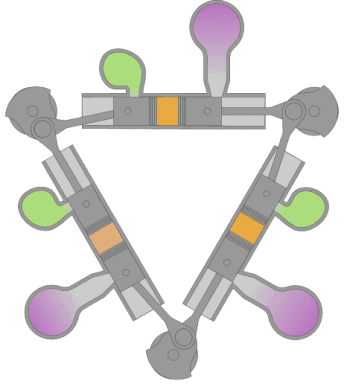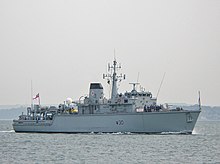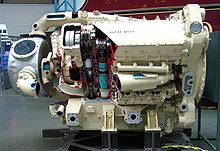Napier Deltic
The Napier Deltic were a series of powerful and compact two-stroke large diesel engines that were developed in the British engine factory Napier & Son around 1950 . The name Deltic is derived from the Greek letter Delta , as the arrangement in longitudinal view is reminiscent of this letter. Due to the elaborate construction and strength, the type was sometimes referred to as the " King of all Diesel Engines ". The Deltic engines were based on the opposed piston engine developed by Hugo Junkers .
History and development of the engines

The history of Deltic engines began in 1944 with an order from the British Navy to Napier to develop a powerful and compact diesel engine for use in speedboats and other fast, small units.
The gasoline engines previously used by the Royal Navy in such cases made the boats in which they were installed very vulnerable due to the fire hazard posed by the fuel, which was a clear disadvantage compared to the diesel-powered speedboats of the German Navy . Diesel fuel has a much higher flash point than gasoline and is not as volatile, which can mean the difference between life and death for the crew in the event of damage from fire in a combat situation.
Up to this point in time, however, diesel engines usually had a high power-to-weight ratio and low achievable speeds, which were not good prerequisites for use in light, fast units. The Napier company was a good addressee for the order from the Navy, as it had taken over licensed construction of modern German opposed piston aircraft diesel engines (such as the Junkers Jumo 205 ) before the Second World War , and had subsequently undertaken further developments in this direction.
The predecessor engine on which the Deltic was built was the Napier Culverin, an opposed piston engine that was primarily intended for installation in the wings of aircraft due to its flat design . Since the navy required much higher performance than could be achieved with this design, Napier came up with the idea of arranging three such engines - as can be seen in the sketch - in an equilateral triangle. It was built in various designs ranging from nine to eighteen cylinders.
At the corners of this triangle are three crankshafts , the power of which is brought together to a common output via a gearbox attached to the end of the engine . Previous attempts to build such engines had failed to find a meaningful coordination of the three crankshafts; Napier solved this problem by having one of the three shafts rotating in the opposite direction to the others.
What was also interesting about this arrangement was that these engines had a scavenging air flow through the cylinders that was always in the same direction ( direct current scavenging , which is why the engines were also known as "uniflow"), which together with the asymmetrical timing (the exhaust ports close before the Intake slots) and the slight turbocharging contributed to the efficiency of the engine.
Testing and use in the Navy

The first Deltic engine was built in 1950, and full testing began with six prototypes in January 1952 . For the experiments, a former speedboat of the German Navy, which was brought to Great Britain as war booty, was used, as the 18-cylinder Deltic engines intended for use in ships had roughly the same power as the Mercedes in -line diesel engines originally used in the speedboats -Benz .
It was already evident at this point that the Deltics were a promising development: The Deltic engines were only half the size of the original in- line engines with the same output (around 3,000 hp) .
After the tests were successful, the Deltics were widely used in fast, small types of ships over the next few decades. The Royal Navy first used them in the Dark-class speedboats and subsequently in a number of smaller combat vehicles and minesweepers . These engines are still in use in the Hunt-class deminers .
Deltic engines were also installed in a number of combat vehicles and PT speed boats used in other navies. Particularly noteworthy here is the Norwegian Tjeld class , from which units were also sold to Germany (where they drove as Schnellboot Type 152 from 1960–1964, NATO numbers P6191 and P6192), Greece and the United States Navy , where they were sold as Nasty- Class (PTF 3 - PTF 22) were known. Units of this class were used by the USA for commando operations during the Vietnam War .
The Tjeld boats had two Deltics with a total of 6,200 hp, a length of 24 meters and a weight of just over 80 tons. With their performance generally described as spectacular, these boats were exactly the application for which these engines were originally developed.
Use in locomotives
The corporate management of English Electric , the parent company of the engine manufacturer Napier, saw the potential of the Deltic engines for use in the railway sector early on and in 1955 initiated the construction of a prototype of a diesel-electric locomotive powered by two Deltics, each throttled to 1,650 hp, under the name DP1 heavy express train service within the UK. The throttling was considered necessary in order to achieve the high reliability and the desired long maintenance intervals required in railway operations.
After extensive testing, 22 series machines of the type designated as Class 55 were delivered in 1961/62 , although these were usually only generally referred to as "Deltics". The prototype DP 1, which received a lot of media attention, had a large “Deltic” lettering on the side for advertising purposes; all later attempts to rename the type (such as "Enterprise") were ultimately useless, as the public had got used to the name that had already been introduced.
Due to the extremely loud and very characteristic engine noise and the fact that these machines were used over a long period of time for the express trains on some of the most important connections in Great Britain, this machine was very well known despite the few examples built and only became final in the late 1970s withdrawn from regular scheduled service (when the faster high-speed trains were available).
Six locomotives were saved from being scrapped when they were decommissioned; some of these specimens have been brought back into running condition by railway enthusiasts and can occasionally be admired (and heard) in front of museum trains.
Use in the Super Pumper System of the FDNY
A Napier Deltic T18-37C diesel engine, throttled from 3100 HP to 2400 HP, served as a pump drive in what was by far the most powerful large tank fire engine of a fire brigade in the world at that time (1964) , the Super Pumper System of the New York City fire brigade . This unit consisted of the Super Pumper itself, a tender with an extinguishing cannon (capacity almost 38,000 liters / minute) and three satellite vehicles also with extinguishing cannons (capacity max. Approx. 15,000 liters / minute). All vehicles were manufactured by Mack Trucks Inc. The DeLaval pump flanged directly to the Napier-Deltic was able to deliver just over 33,300 liters of extinguishing water per minute at a pressure of approx. 24 bar, or approx. 16,650 liters provide approx. 48 bar pressure. Under full load, the diesel consumption of the Napier-Deltic T18-37C of the Super Pump was over 500 liters / hour. With the diesel supply that was carried along, the Super Pumper could be operated for three hours without refueling. The Super Pumper System remained in use until 1982, the revised satellites even longer.
The pumper can be viewed today at the Antique Toy and Firehouse Museum in Bay City, Michigan .
business
The Deltic motors were a remarkable design that combined an excellent power-to-weight ratio with a very compact design. A general disadvantage is that it was almost inevitably a sophisticated construction, the reliability of which always depended heavily on proper maintenance and care.
On the websites of marine veterans there are comments from former machinists who say that some of the crews were even afraid of these engines because they were difficult to handle and that there was apparently the danger, especially during the complicated starting process carried out with compressed air, that the engine explodes. Problems of this kind - even if they should have been frequent - have practically only affected the marine sector, since only Deltics with reduced power were used in locomotives for reasons of safety and economy.
The availability of ships and locomotives equipped with these units was, however, very good despite the fragility of the engines, as they were designed from the outset to be replaced in one piece in the event of problems and to be repaired in the factory; the vehicles were in the meantime operated with exchange engines. This type of replacement maintenance was pioneering and later became a widespread practice.
Technical specifications
- Type Napier Deltic T18-37K
- Design: Liquid-cooled opposed piston two-stroke diesel engine with three crankshafts and external flushing fan
- Number of cylinders: 18, in three banks with six cylinders each in a triangular arrangement
- Bore: 130.17 mm (5.125 in)
- Stroke: 184.15 mm (7.25 in), each × 2
- Total displacement: 88.3 l (5,384 in 3 )
- Power: 2.31 MW (3,100 bhp ) at 2100 min -1
- Average piston speed : 12.89 m / s (2538 ft / min) at 2,100 min −1
- Length: 3912 mm (154 in)
- Width: 1905 mm (95 in)
- Height: 2133 mm (84 in)
- Mass: 6,182 kg (13,630 lb) - dry, with gearbox
Web links
- 3D animation of the crankshafts and cylinders of a Deltic machine in action .
- Technical details about the engines on a website about the Tjeld / Nasty class speedboats .
- The Deltic Preservation Society - a society for the preservation of Deltic locomotives .
- Hunt-class deminers ( Memento July 28, 2006 on the Internet Archive ).


